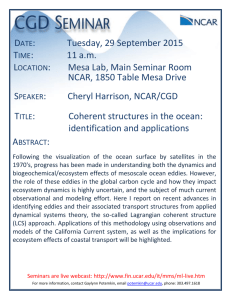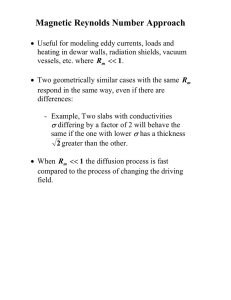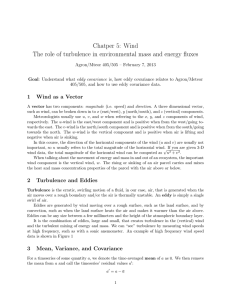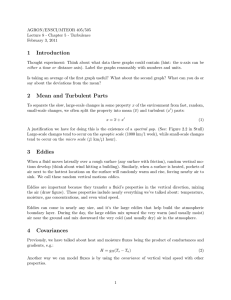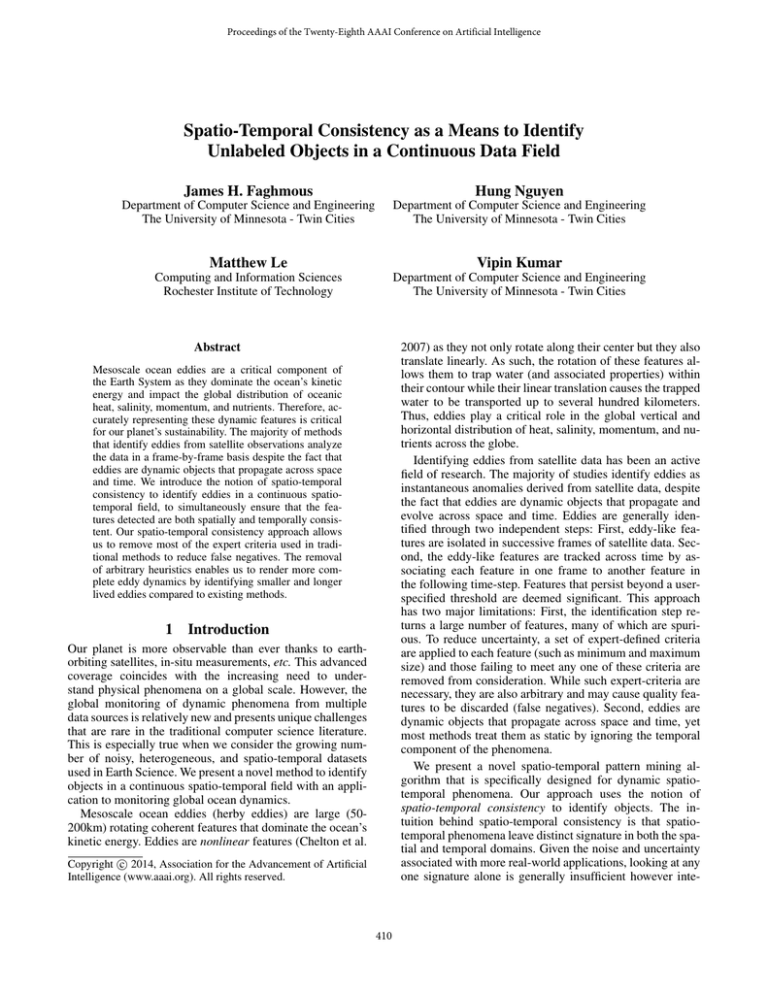
Proceedings of the Twenty-Eighth AAAI Conference on Artificial Intelligence
Spatio-Temporal Consistency as a Means to Identify
Unlabeled Objects in a Continuous Data Field
James H. Faghmous
Hung Nguyen
Department of Computer Science and Engineering
The University of Minnesota - Twin Cities
Department of Computer Science and Engineering
The University of Minnesota - Twin Cities
Matthew Le
Vipin Kumar
Computing and Information Sciences
Rochester Institute of Technology
Department of Computer Science and Engineering
The University of Minnesota - Twin Cities
Abstract
2007) as they not only rotate along their center but they also
translate linearly. As such, the rotation of these features allows them to trap water (and associated properties) within
their contour while their linear translation causes the trapped
water to be transported up to several hundred kilometers.
Thus, eddies play a critical role in the global vertical and
horizontal distribution of heat, salinity, momentum, and nutrients across the globe.
Identifying eddies from satellite data has been an active
field of research. The majority of studies identify eddies as
instantaneous anomalies derived from satellite data, despite
the fact that eddies are dynamic objects that propagate and
evolve across space and time. Eddies are generally identified through two independent steps: First, eddy-like features are isolated in successive frames of satellite data. Second, the eddy-like features are tracked across time by associating each feature in one frame to another feature in
the following time-step. Features that persist beyond a userspecified threshold are deemed significant. This approach
has two major limitations: First, the identification step returns a large number of features, many of which are spurious. To reduce uncertainty, a set of expert-defined criteria
are applied to each feature (such as minimum and maximum
size) and those failing to meet any one of these criteria are
removed from consideration. While such expert-criteria are
necessary, they are also arbitrary and may cause quality features to be discarded (false negatives). Second, eddies are
dynamic objects that propagate across space and time, yet
most methods treat them as static by ignoring the temporal
component of the phenomena.
We present a novel spatio-temporal pattern mining algorithm that is specifically designed for dynamic spatiotemporal phenomena. Our approach uses the notion of
spatio-temporal consistency to identify objects. The intuition behind spatio-temporal consistency is that spatiotemporal phenomena leave distinct signature in both the spatial and temporal domains. Given the noise and uncertainty
associated with more real-world applications, looking at any
one signature alone is generally insufficient however inte-
Mesoscale ocean eddies are a critical component of
the Earth System as they dominate the ocean’s kinetic
energy and impact the global distribution of oceanic
heat, salinity, momentum, and nutrients. Therefore, accurately representing these dynamic features is critical
for our planet’s sustainability. The majority of methods
that identify eddies from satellite observations analyze
the data in a frame-by-frame basis despite the fact that
eddies are dynamic objects that propagate across space
and time. We introduce the notion of spatio-temporal
consistency to identify eddies in a continuous spatiotemporal field, to simultaneously ensure that the features detected are both spatially and temporally consistent. Our spatio-temporal consistency approach allows
us to remove most of the expert criteria used in traditional methods to reduce false negatives. The removal
of arbitrary heuristics enables us to render more complete eddy dynamics by identifying smaller and longer
lived eddies compared to existing methods.
1
Introduction
Our planet is more observable than ever thanks to earthorbiting satellites, in-situ measurements, etc. This advanced
coverage coincides with the increasing need to understand physical phenomena on a global scale. However, the
global monitoring of dynamic phenomena from multiple
data sources is relatively new and presents unique challenges
that are rare in the traditional computer science literature.
This is especially true when we consider the growing number of noisy, heterogeneous, and spatio-temporal datasets
used in Earth Science. We present a novel method to identify
objects in a continuous spatio-temporal field with an application to monitoring global ocean dynamics.
Mesoscale ocean eddies (herby eddies) are large (50200km) rotating coherent features that dominate the ocean’s
kinetic energy. Eddies are nonlinear features (Chelton et al.
c 2014, Association for the Advancement of Artificial
Copyright Intelligence (www.aaai.org). All rights reserved.
410
grating both spatial and temporal information can provide a
powerful object identification framework especially in unsupervised settings where ground truth data are unavailable.
Within this framework, instead of using strict criteria to
prune objects, only features that are simultaneously consistent in space and time are considered. Using space-temporal
consistency instead of expert heuristics allows us to identify
a non-trivial number of eddies that would fail the heuristic
yet they contribute to global ocean dynamics.
2
Background
2.2
Ant
i
cycl
oni
cEddy
Cycl
oni
cEddy
Sea
Sur
f
ace
There are four major aspects that characterize eddies:
their radius, amplitude, geodesic (rotational) speed, and their
lifetime. The first three can be computed instantaneously
from a single satellite snapshot, while life-time can only be
computed once a feature is tracked. In this paper we will focus mainly on the eddy size as measured in pixels and their
amplitude, which is the difference between the SSH of the
eddy’s extrema and the mean SSH of the eddy’s periphery.
The majority of studies consider a feature from satellite data
to be significant if it has at least 9 pixels, more than 1cm in
amplitude, and persists for a least 4 weeks.
Sea
Sur
f
ace
Figure 1: A cartoon of a cyclonic (left) and an anticyclonic
eddy (right). The direction of rotation of the eddy causes
the sea surface to either increase or decrease within the
eddy’s contour. Some important eddy characteristics are its
size (measured in pixels) and its amplitude which is the difference between the sea surface height extrema within the
eddy’s interior and the mean surface height of the eddy’s
permitter.
2.1
Why Ocean Eddies Matter
Monitoring global ocean dynamics plays a critical role in
ensuring future sustainability. Ocean eddies are a fundamental component of the ocean dynamics and have significant impacts on a wide range of atmospheric and oceanographic phenomena. Eddies have been shown to impact the
atmosphere in their direct vicinity by influencing sea surface temperatures that in turn impact near-surface winds,
clouds, and rainfall (Frenger et al. 2013). Eddies have also
been shown to impact marine ecosystems by raising the
deep nutrient-rich water to the surface, which renews the
nutrient supply to phytoplankton and subsequently leads
to increased fish production (Denman and Gargett 1983;
Chelton et al. 2011). Additionally, eddies might interact with
other large systems. For instance, one study found that a
7000-year-old coral reef was asphyxiated due to massive
phytoplankton blooms, that were linked to a large eddy
(Rahul et al. 2010). Similarly, some of the recent devastating hurricanes, including Hurricane Katrina, gained intensity in the Gulf of Mexico when passing over a warm-core
eddy (Jaimes and Shay 2009). Finally, Southern Ocean eddies known as “Agulhas rings” may act as a moderating factor in global climate change when their warm and salty water
reaches the upper arm of Atlantic Meridional Overturning
Circulation (AMOC) where waters have become cooler and
less salty because of Arctic ice melting (Beal et al. 2011).
Ocean Eddies: An Overview
Ocean eddies are coherent rotating structures of water that
span tens to hundreds of kilometers and last for several
weeks and up to years. Eddies are ubiquitous and during any
given week nearly 4,000 eddies can be detected in satellite
data (Faghmous et al. 2013).
Eddies are categorized based on their rotational direction.
They are either cyclonic if they rotate counter-clockwise (in
the Northern Hemisphere) or anticyclonic otherwise. Cyclonic eddies, like the one in Figure 1 (left), cause a decrease
in sea surface height (SSH) and elevations in subsurface density surfaces. Anti-cyclonic eddies, such as the one depicted
in Figure 1 (right), cause an increase in SSH and depressions in subsurface density surfaces. These characteristics
allow us to identify ocean eddies in SSH satellite data. Anticyclonic eddies can be seen in ellipse-shaped regions of positive SSH anomalies, while cyclonic eddies are reflected in
closed contoured negative SSH anomalies. The opposite rotation causes each type of eddy to have an opposite impact
on various ocean properties. For simplicity, when we refer
to the impact of an eddy we mean a cyclonic eddy with the
understanding that an anticyclonic eddy would have the opposite effect. For instance, cyclonic eddies tend to have cold
cores and we implicitly mean that anticyclonic have warm
cores.
2.3
Eddy Monitoring In Satellite Products
Until recently, ocean eddies were tracked using sea surface
temperatures and ocean surface color. However many phenomena influence sea surface temperatures and color other
than eddies. As a result, SSH are the most widely used data.
Traditionally, eddies have been identified independently in a
satellite snapshot without accounting for time. Some studies identified eddies based on a measure of rotation and
deformation in fluid flow known as the Okubo-Weiss (W)
parameter (Isern-Fontanet, Garcı́a-Ladona, and Font 2003;
Chelton et al. 2007). In such studies, eddies were defined
as features where the W-parameter was below an expertspecified negative threshold. Other studies identified eddies through a wavelet-packet decomposition of the SSH
field (Doglioli et al. 2007). Finally, more recent studies
employed an iterative-threshold approach to isolate closecontour anomalies from the background (Chelton, Schlax,
and Samelson 2011; Faghmous et al. 2012).
Although each approach is slightly different with various
tradeoffs, these methods share one common pitfall: they all
411
rely on expert criteria to identify objects and reduce the risk
of false positive. In fact some of these methods are so sensitive to parameterization that they report a 50% difference
in results depending on the threshold used (Souza, de Boyer
Montégut, and Le Traon 2011).
2.4
coherent features across space and time, existing methodologies fail to take advantage of such structure and introduce
unnecessary uncertainty by analyzing four-dimensional data
(latitude, longitude, time, and sea surface height) as three
dimensional.
Instead of relying on a static view coupled with arbitrary
parameters, we take inspiration from the physical world to
identify spatio-temporal objects. In the physical world, we
generally think of an object existing or not based on whether
it is spatio-temporally consistent. For instance, an object can
only exist if its body is spatially consistent – all its molecules
are tightly packed in the proper form, etc. Additionally an
object must be temporally consistent – it can only be at one
place at a time. We call this insight that objects have distinct
and complimentary signatures in space and time as spatiotemporal consistency.
We use this general notion of spatio-temporal consistency
to identify eddies in the continuous spatio-temporal field
based on known signals they leave in spatial and temporal
domains. We define an eddy feature as a group of spatiotemporally consistent SSH anomalies:
Spatial consistency: Depending on their rotational direction, eddies can be seen as closed-contour positive or negative anomalies. Furthermore, (Chelton, Schlax, and Samelson 2011) showed that mesoscale eddies can be approximated in space as axially symmetric Gaussian structures of
the form
h(r) = Aexp(−r2 /L2e )
(1)
Challenges
Monitoring eddies presents stimulating computer science
challenges that generalize to numerous problems that deal
with spatio-temporal data. There as several conceptual and
computational challenges when trying to mine objects in a
continuous spatio-temporal field. First, the very notion of
objects is subjective and uncertain. This is due to the fact that
the objects are not directly observable (compared to identifying a clear object such as a car in an image). Instead, we
must rely on proxy data to infer the presence or absence of
an object. For our application, we cannot directly observe
the actual eddies unless we were able to measure subsurface information (eddies can span tens of meters vertically
into deep waters), thus we rely on an imprecise estimate of
an eddy’s impact of the observable sea surface height field.
Furthermore, the spatio-temporal autocorrelation within the
field (some from post-processing) makes the data smooth
and as a result it is difficult to identify the object’s exact
boundaries. Second, the proxy data tend to be extremely
variable, which makes developing parameter-free methods
challenging. Some of the variability is due to natural variability in the Earth System., while other sources of variability include measurement error and our incomplete understanding the processes that drive many natural phenomena
(model representation). Finally, a growing number of domains lack ground truth data for evaluation. In the case of
eddies, the majority of algorithms use anecdotal field studies
to validate their methods. Thus there is a need for novel objective evaluation methods for unsupervised learning algorithms in science. For a deeper discussion of the challenges
and opportunities in spatio-temporal data mining see (Faghmous and Kumar 2013).
2.5
where h is SSH, r is the radial distance from the eddy
centroid, A is the eddy amplitude, and Le is the e-folding
scale for the eddy. (Chelton, Schlax, and Samelson 2011)
estimated for a mesoscale eddy in the AVISO dataset Le ≈
0.4◦ . That is, given that an eddy’s center is its local extrema,
the remaining pixels in the eddies contour should obey axisymmetric Gaussian change 2 . Here we use the iterative
thresholding method introduced by (Faghmous et al. 2013)
to identify spatially consistent SSH anomalies. Due to space
limitations, we will focus on the novel temporal component
of our algorithm.
Temporal consistency: As moving objects, eddies impact a wide range of regions. When an eddy passes over a
region, their slow transitional speed of 10km/week (Frenger
et al. 2013) causes them to leave a unique signal in the temporal profile of regions they pass through. Figure 2 demonstrates such impact. As an eddy approaches a region, the
SSH gradually decreases and will reach a local (temporal)
minima when the eddy is on top of that region. The SSH will
then gradually return to its initial height as the eddy moves
away.
To quantify how likely an eddy passed by a given location,
we analyze each grid location which can be characterized
by an SSH time-series denoting that location’s SSH temporal evolution. Each location is susceptible to interact with
a cyclonic eddy, an anticyclonic one, or neither. As mentioned above, the presence of an eddy causes that location
to have a local extrema in time, thus we search for all local
extrema (minima and maxima for cyclonic and anticyclonic
Data and Research Objectives
In this study, we identify spatio-temporal objects (eddies) in
continuous SSH anomaly data. We use the Version 3 dataset
of the Archiving, Validation, and Interpretation of Satellite
Oceanographic (AVISO) which contains 7-day averages of
SSH on a 0.25◦ grid from October 1992 through January
2011 1 . In addition to identifying spatially consistent features (i.e. their physical contour), we wish to analyze how
consistent they are in time and use such consistency as a
measure of certainty that could replace the strict heuristics
commonly used in the literature.
3
Methods
The majority of eddy detecting algorithms focus primarily
on identifying features independently in space, and use strict
criteria concerning a feature’s physical attributes as means to
reduce false positives. Thus, despite the fact that eddies are
1
Available at http://www.aviso.oceanobs.com/es/data/products/
sea-surface-height-products/
2
412
See figure 15 in (Chelton, Schlax, and Samelson 2011)
SSH (cm)
1
2
3
4
5
6
7
8
9
10
11
1
5!
0!
-5!
-10!
-15!
-20
2
3
4
5
6
7
8
9
10
11
5!
0!
-5!
-10!
-15!
-20
0
2
4
6
8
10
12
Time (weeks)
(weeks)
Time
14
16
18
20
1
2
3
4
5
6
7
8
9
10
1
11
0
2
4
6
8
10
12
14
Time
Time(weeks)
(weeks)
16
18
20
2
3
4
5
6
7
8
9
10
11
1
5!
0!
-5!
-10!
-15!
-20
5!
0!
-5!
-10!
-15!
-20
0
2
4
6
8
10
12
14
16
18
20
2
3
4
2
4
6
5
6
8
10
7
8
9
10
11
5!
0!
-5!
-10!
-15!
-20
0
2
Time (weeks)
4
6
8
10
12
14
Time (weeks)
Time (weeks)
16
18
20
0
12
14
Time (weeks)
(weeks)
Time
16
18
20
Figure 2: An eddy’s footprint on a location’s temporal SSH profile. Top row: a spatial view of the SSH anomalies as a cyclonic
eddy moves from right to left. The eddy can be seen as the large negative (blue) ellipse propagating through the field. Bottom
row: The temporal view of the SSH anomalies at the location highlighted by the arrow in the top row (center pixel in the spatial
view). The SSH anomalies are near +5cm before the eddy reaches the location of interest. As the eddy draws nearer the SSH
anomalies gradually decrease until they reach a minimum when the eddy’s passes through that pixel. The eddy’s passing through
this location causes a 30cm change in SSH over 14 weeks. The slow and gradual impact on SSH is the temporal footprint eddies
have on SSH.
eddies respectively) along the 954 week time-series (nearly
20 years). To test how significant the imprint of the eddy
was, we compute the area above the curve (for cyclonic eddies) as a measure of the strength of the signal. We expect
stronger eddies to leave a larger area or a deeper imprint on
locations it passes by. For any pixel pi in a satellite snapshot
at time ti we can score it as a function of how far (in time) is
ti from the the time the nearest temporal extrema occurred
at pi and how deep was the temporal imprint at pi . Formally,
t
we assign a score sij for each pixel pi at time tj :
Aext
t
sij =
(2)
|tj − text | + 1
where Aext is the area over/under the curve for the nearest local extrema and text is the time at which the nearest
t
extrema occurred at pi . Thus, sij will be high when both
the area created by the extrema is high and when the current time tj is close to the time when the nearest extrema
occurred (text ). We take the absolute value of the distance
in time to avoid negative quantities. We add one to the time
difference to avoid dividing by zero when tj = text .
Figure 3 demonstrates how we score each location (or
pixel pi ) for a given time tj . First, all maxima and minima
the 20-year time-series are identified (in red and green respectively). Then for a given time tj we search for the nearest temporal extrema text . In this case, let’s assume we are
looking for the imprint of cyclonic eddies, thus we are interested in sustained depressions (i.e. minima) in SSH 3 . In
this example, tj is at 20 weeks and the nearest minima is at
text = 18 weeks. The area above the local minima at text
is Aext and is computed as the area between the dashed line
and the time-series curve. Aext is approximatively 80. Thus
t
80
= 26.6 We
the score for the pixel pi at tj is sij = (20−18)+1
assign the temporal score of an entire eddy by averaging the
temporal scores of all pixels within the contour of the eddy
as identified in space.
Using these two definitions, we can now have a spacetime consistency model for ocean eddies in SSH: features
30
Seaheight
surface height
Sea surface
anomalies (cm)
20
10
0
−10
Aext
−20
−30
−40
−50
0
10
text 20
tj
30
TimeTime
(weeks)
40
50
60
Figure 3: An SSH time-series at a single pixel. Each green
and red square denote a local minimum and maximum respectively. We search for all “U” shaped segments by simply ascending to the left and right of each local minimum.
Once the two maxima surrounding the local minimum are
identified, we compute the area over the curve (for cyclonic
eddies) between the SSH time-series and a horizontal dashed
line drawn from the smallest of the two maxima.
3
for anticyclonic eddies we would analyze the increases in SSH
and their maxima
413
the spatial consistency step. Each pixel at time ti is given a
score as a function of the area over/under the curve closest
to the current time-step using equation 2. We then average
the scores of the “inside eddy” pixels and the “outside eddy”
pixels for each week. Figure 5 shows the weekly mean of the
temporal scores of the pixels contained in an eddy (top red
curve) and those that are outside an eddy (top black curve).
The bottom row in Figure 5 shows the weekly standard deviation of eddy and non-eddy pixels respectively. We we see
is that pixels that are within an eddy tend to have a significantly higher temporal score than those that do not.
Not only does our temporal score provide a meaningful
signal about the presence or absence of eddies, it also carries information about the potential lifetime or an eddy (via
how strong the eddy is when passing by a location). Figure
6 segments the eddy pixels from the red curve in the top left
panel of Figure 5 by the lifetime of the eddy the pixel was in.
The scores get progressively better as the eddies live longer.
The bottom row in Figure 6 shows the standard deviations
of the scores and highlights that the variability decreases for
longer lived eddies.
Figure 4: The different and complimentary views of the data.
Left: raw SSH where a cyclonic eddy can be seen as close
contour negative anomaly. Center: the resulting connected
component from the iterative thresholding method. Right:
The score of each pixel based our temporal scoring method.
The source code along with an interactive eddy viewer
are available for download and to contribute to as an OpenSource project at: www.ucc.umn.edu/eddies
20
10
10
0
0
0
200
400
Time
600
800
Score standard deviation of all cyclonic eddy pixels
80
30
20
30
20
30
20
30
20
20
10
0
200
400
Time
600
800
Score
60
40
20
40
20
0
200
400
Time
600
800
0
0
200
400
Time
600
800
3.2
Figure 5: Variation over time (in weeks) of mean temporal
scores of pixels within eddies (eddy pixels) and pixels outside eddies (non-eddy pixels). The bottom row shows the
standard deviations of the scores. The scores for eddy pixels are significantly higher than those of pixels that are not
within an eddy.
3.1
0
0
200
400
600
Time
(weeks) 600
200 Time400
TrackTime
length 2−3
80
20
10
10
0
800
0
800
Score
Score
40
30
0
0
80
Track length 2−3
200
400
600
Time
(weeks) 600
200 Time400
TrackTime
length 4−6
20
10
10
0
800
0
800
0
0
200
400
600
Time
(weeks) 600
200 Time
400
TrackTime
length 7−9
80
Track length 4−6
20
10
10
0
800
0
800
80
60
80
60
60
40
60
40
60
40
60
40
20
0
0
0
200
0
200
400
600
Time
400
600
Time
Time
(weeks)
800
800
Score
Score
80
60
40
20
20
0
0
0
200
0
200
400
600
Time
400
600
Time
Time
(weeks)
800
800
40
20
20
0
0
0
200
0
200
400
600
Time
400
600
Time
Time
(weeks)
0
0
80
Track length 7−9
80
60
40
20
Track length 10+
800
800
200
400
600
Time
(weeks) 600
200 Time400
TrackTime
length 10+
800
800
Track length 10+
40
20
20
0
0
0
200
0
200
400
600
Time
400
600
Time
Time
(weeks)
800
800
Figure 6: The mean scores of pixels that are within an eddy
from Figure 5 but further segmented by the lifetime of the
eddy in question. For shorter lived eddies (leftmost and second from left panels) the scores tend to be lower than the
average score of an eddy pixel. However, as the quality of
the eddies increase as seen by longer lifetimes, the temporal
scores become higher and are less variable. This is an indication that our proposed temporal score has both a signal
for the likelihood of the presence of an eddy at any given
location as well as the potential lifetime of eddy passing by
a location.
Score standard deviation of non eddy pixels
80
60
Score
20
Track length 10+
40
Track length 7−9
40
30
10
0
Score
Score
30
Score
Score
30
0
Standard deviation of temporal scores
Average temporal scores of non eddy pixels
40
Track length 7−9
40
Track length 4−6
40
30
0
Average temporal scores of all cyclonic eddy pixels
40
Track length 4−6
40
Track length 2−3
40
30
Score
Score
Mean temporal scores
Track length 2−3
40
Score
Score
Temporal Imprint
Score
Score
Spatial Imprint
Score
Score
Raw SSH
Score
Score
must be a closed-contour local anomalies and those regions
that make the eddy’s interior must have a slowly decreasing
(increasing) SSH profile in the temporal domain. Figure 4
shows the complimentary spatio-temporal view of the data.
Notice that each view is imperfect but together they provide
a more certain view of the object.
The Impact of Expert Heuristics
While heuristics are necessary to ensure significant features are discovered, their strict and arbitrary nature make
them prone to discarding real features that fall below certain thresholds. Using the temporal scores as an alternative,
we removed all expert criteria used in previous studies (e.g.
(Chelton, Schlax, and Samelson 2011)) such as the minimum feature size of 9 pixels. Once all features we discovered using the iterative thresholding method described in
(Faghmous et al. 2013) were identified in space, we applied
our proposed temporal scoring mechanism to those features
and added the features that did not meet the traditional 9
pixel minimum size criteria as well as those that has a subcentimeter amplitude to the candidate features to be tracked.
The Significance of The Temporal Scores
We begin our analysis by verifying that the temporal consistency score has a meaningful signal on a global scale. To
do so, for any global snapshot of weekly data, we classify
pixels as either within an eddy or outside an eddy based
on whether that pixel was labeled as part of an eddy from
414
We restricted the newly added features to those with top
50% scores regardless of size and tracked the features across
space and time using the tracking algorithm described in
(Chelton, Schlax, and Samelson 2011).
Based on this setup, the heuristics method identified
146,336 features in one year of data (2009). Our spatiotemporal consistency method identified nearly thirty percent
more features during the same period with 195,967. This is
because we do not throw away features that fail any of the
expert heuristics. Figure 7 shows the ratio of total features
that went on to live a certain amount of weeks. Notice that
the ratio of untracked features are higher for our method
because, as the experts suggested, removing the heuristics
will introduce many spurious features. That being said, our
method then performs very similarly to the heuristic-based
algorithm as we get to longer lived and thus more significant
features. Note that the ratio of long-lived tracks are similar
while we detect a third more eddies. This suggests that expert heuristics remove a significant number of high quality
features from the analysis.
Expert Heuristics
we focus on the minimum size heuristic.
Figure 8 shows the track density for 20094 of tracks that
lasted longer than 4 weeks yet contained a feature that had
fewer than 9 pixels. We only included the highest scoring
small features as described in the previous section. One can
notice a clear concentration of significant tracks with small
eddies near the poles as well as along the major currents
in the North West Atlantic and North West Pacific oceans.
This analysis demonstrates the value of introducing spatiotemporally consistent features despite them not meeting the
strict heuristics of traditional eddy monitoring algorithms.
Spatio-Temporal Consistency
Ratio of total features
0.4
0.3
Figure 8: Track density for tracks that lasted at least 4 weeks
and contained a feature smaller than 9 pixels that was temporally consistent according to our temporal scoring mechanism. Notice the high density regions near the poles and
along the major currents in the North Western Atlantic and
North Western Pacific oceans. These tracks would have been
completely missed if one used the strict minimum eddy size
of 9 pixels. Only one year of data was used (2009) to highlight the high density regions with small eddies.
0.2
0.1
0
Untracked
3 Weeks
5 Weeks
7 Weeks
9 Weeks
Total lifetime of feature
Figure 7: The ratio of total features that lived a certain lifetime. Imposing the expert heuristics results in 146,336 features. Relaxing such constrains and using spatio-temporal
consistency instead allows us to identify 195,967 features.
Despite identifying nearly thirty percent more features, the
percentage of features that persist for a certain lifetime remain very similar between the two methods, especially when
we move into the longer lived eddies (4+ weeks). This shows
that the expert heuristics remove a large number of high
quality eddies.
3.3
4
Conclusion and Future Work
The majority of eddy identification algorithms rely on necessary yet arbitrary heuristics to reduce the risk of false discovery. We introduced an alternative approach that objectively
identifies eddies by simultaneously monitoring a feature’s
consistency in space and time. The introduction of the concept of temporal consistency allows us to give a confidence
score to each feature identified in space without the need
of completely discarding it because it might have failed to
meet an arbitrary threshold. Keeping features that are spatiotemporally consistent yet fail to meet certain heuristics allows us to observe richer ocean dynamics. Now that we
have shown that spatio-temporal consistency can be used as
a confidence metric, new eddy identification and tracking algorithms can be more robust by re-imagining the way eddy
tracks are constructed.
In the traditional approach, all eddy-like features are first
identified without any temporal information. Any feature
What the Heuristics Hide
One of the main limitations of applying strict heuristics is
that eddies with certain properties tend to be highly concentrated in certain regions in the world. For instance, eddies
decrease monodically in size from the equator to the poles,
thus high latitude eddies tend to be smaller than their equatorial counterparts (Fu et al. 2010). Here we show that when
we visualize the density of the tracks associated with features that the strict heuristic approaches would not consider
we quickly see the impact of such heuristics on our understanding of global ocean dynamics. Due to space limitations,
4
Due to the high number of such tracks we show only a single
year of data to easily highlight regions of high “small eddy” density
415
Frenger, I.; Gruber, N.; Knutti, R.; and Münnich, M. 2013.
Imprint of southern ocean eddies on winds, clouds and rainfall. Nature Geoscience 6(8):608–612.
Fu, L.; Chelton, D.; Le Traon, P.; and Morrow, R. 2010.
Eddy dynamics from satellite altimetry. Oceanography
23(4):14–25.
Isern-Fontanet, J.; Garcı́a-Ladona, E.; and Font, J. 2003.
Identification of marine eddies from altimetric maps. Journal of Atmospheric and Oceanic Technology 20(5):772–778.
Jaimes, B., and Shay, L. K. 2009. Mixed layer cooling in
mesoscale oceanic eddies during hurricanes katrina and rita.
Monthly Weather Review 137(12):4188–4207.
Rahul, P.; Salvekar, P.; Sahu, B.; Nayak, S.; and Kumar,
T. S. 2010. Role of a cyclonic eddy in the 7000-yearold mentawai coral reef death during the 1997 indian ocean
dipole event. Geoscience and Remote Sensing Letters, IEEE
7(2):296–300.
Souza, J.; de Boyer Montégut, C.; and Le Traon, P. Y. 2011.
Comparison between three implementations of automatic
identification algorithms for the quantification and characterization of mesoscale eddies in the South Atlantic Ocean.
Ocean Science 7(3):317–334.
that fails to meet the expert heuristics is discarded and the remaining features are tracked from one time-step to the next
by attaching each feature at time t with its nearest spatial
neighbor in t + 1. However, we have shown that not all features are created equal and instead of starting the tracking
with all available features our temporal score would allow
us to first track the most certain (i.e. highest quality) features
first, and gradually insert less certain features to simply complement high quality tracks (by extending them or connecting them). This would allow for higher quality tracks while
giving the power to the researcher to select which level of
uncertainty she is willing to accept.
Acknowledgments
We thank the three anonymous reviewers whose suggestions
improved the manuscript’s clarity. This work was funded by
an NSF Expeditions in Computing Grant #1029711 and an
NSF EAGER grant #1355072.
References
Beal, L. M.; De Ruijter, W. P.; Biastoch, A.; Zahn, R.; et al.
2011. On the role of the agulhas system in ocean circulation
and climate. Nature 472(7344):429–436.
Chelton, D.; Schlax, M.; Samelson, R.; and de Szoeke, R.
2007. Global observations of large oceanic eddies. Geophysical Research Letters 34:L15606.
Chelton, D. B.; Gaube, P.; Schlax, M. G.; Early, J. J.;
and Samelson, R. M. 2011. The influence of nonlinear
mesoscale eddies on near-surface oceanic chlorophyll. Science 334(6054):328–332.
Chelton, D.; Schlax, M.; and Samelson, R. 2011. Global
observations of nonlinear mesoscale eddies. Progress in
Oceanography.
Denman, K., and Gargett, A. 1983. Time and space scales of
vertical mixing and advection of phytoplankton in the upper
ocean. Limnology and Oceanography 801–815.
Doglioli, A. M.; Blanke, B.; Speich, S.; and Lapeyre, G.
2007. Tracking coherent structures in a regional ocean
model with wavelet analysis: Application to cape basin eddies. Journal of Geophysical Research: Oceans (1978–
2012) 112(C5).
Faghmous, J. H., and Kumar, V. 2013. Spatio-temporal data
mining for climate data: Advances, challenges, and opportunities. In Chu, W., ed., Data Mining and Knowledge Discovery for Big Data: Methodologies, Challenges, and Opportunities. Springer.
Faghmous, J. H.; Styles, L.; Mithal, V.; Boriah, S.; Liess, S.;
Vikebo, F.; Mesquita, M. d. S.; and Kumar, V. 2012. Eddyscan: A physically consistent ocean eddy monitoring application. In Intelligent Data Understanding (CIDU), 2012
Conference on, 96 –103.
Faghmous, J. H.; Le, M.; Uluyol, M.; Chaterjee, S.; and Kumar, V. 2013. Parameter-free spatio-temporal data mining to
catalogue global ocean dynamic. In Thirteenth International
Conference on Data Mining (ICDM-13).
416

